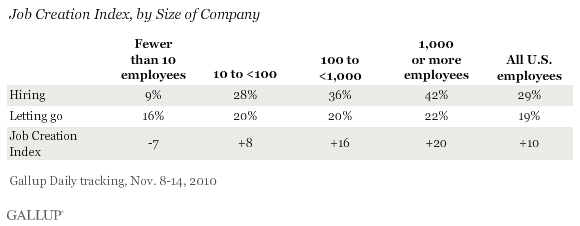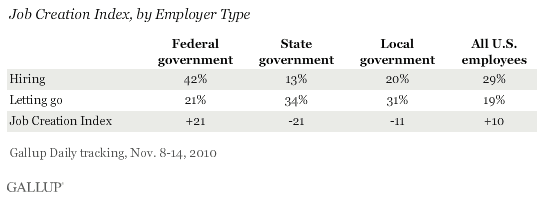PRINCETON, NJ -- Gallup's Job Creation Index was at +10 during the week ending Nov. 14, with 29% of employees reporting that their employer is hiring and 19% saying their employer is letting people go, matching the best monthly performance of 2010.

Gallup finds that larger companies are hiring more workers while the smallest businesses are shedding jobs. More than 4 in 10 employees (42%) at workplaces with at least 1,000 employees reported during the week ending Nov. 14 that their company was hiring, while 22% said their employer was letting people go. At the other extreme, 9% of workers in businesses with fewer than 10 employees said their employer was hiring, and 16% said their employer was letting people go.

This Gallup question about company size is new, so it is unclear whether this pattern is a continuation of, or a change from, the past.
Hiring Also Much Higher at the Federal Government
The federal government is hiring more employees than it is letting go, while the opposite is true for state and local governments. More than 4 in 10 federal employees (42%) say their organizations are adding people and 21% say they are letting workers go. In contrast, state and local government employees report a net loss of workers.

That pattern has been consistent throughout the year -- with net gains in federal hiring and net losses in state and local government hiring.
Commentary
Gallup's Job Creation Index, based on employees' reports of hiring and letting go at their places of work, shows job market conditions keeping pace with the best monthly level of 2010 during the first two weeks of November. Still, improvement has been marginal at best since August, and the job situation remains about where it was in October 2008 as the financial crisis was underway. This is probably one reason unemployment tops Americans' list of the most important problems facing the country today.
Gallup data suggest that part of the jobs problem continues to be centered in state and local governments. Unlike the federal government, these entities need to adjust their employment to their declining revenues. As a result, their employment situation is likely to reflect the economic downturn for some time to come, because state and local revenues tend to trail economic upturns.
Another part of the problem involves the nation's smallest businesses. The entrepreneurs who tend to run these businesses appear to be having a particularly difficult time in 2010. Getting jobs growing in this area is essential to the achievement of a real jobs recovery. In turn, this suggests that encouraging entrepreneurship should be a top U.S. priority going forward.
Finally, for those looking for a job, it appears larger companies are the best bet in the private sector, and the federal government in the public sector.
Gallup.com reports results from these indexes in daily, weekly, and monthly averages and in Gallup.com stories. Complete trend data are always available to view and export in the following charts:
Daily: Employment, Economic Confidence and Job Creation, Consumer Spending
Weekly: Employment, Economic Confidence, Job Creation, Consumer Spending
Read more about Gallup's economic measures.
Survey Methods
For Gallup Daily tracking, Gallup interviews approximately 1,000 national adults, aged 18 and older, each day. The Gallup Job Creation Index results are based on a random sample of approximately 500 current full- and part-time employees each day.
National results for the week ending Nov. 14 are based on Gallup Daily tracking interviews with 3,991 employees. For this sample, one can say with 95% confidence that the maximum margin of sampling error is ±2 percentage points. Results for businesses by size for the week ending Nov. 14 are based on interviews totaling about 1,000. For each total segment sample, the maximum margin of sampling error is ±4 percentage points.
Interviews are conducted with respondents on landline telephones and cellular phones, with interviews conducted in Spanish for respondents who are primarily Spanish-speaking. Each daily sample includes a minimum quota of 150 cell phone respondents and 850 landline respondents, with additional minimum quotas among landline respondents for gender within region. Landline respondents are chosen at random within each household on the basis of which member had the most recent birthday.
Samples are weighted by gender, age, race, Hispanic ethnicity, education, region, adults in the household, cell phone-only status, cell phone-mostly status, and phone lines. Demographic weighting targets are based on the March 2009 Current Population Survey figures for the aged 18 and older non-institutionalized population living in U.S. telephone households. All reported margins of sampling error include the computed design effects for weighting and sample design.
In addition to sampling error, question wording and practical difficulties in conducting surveys can introduce error or bias into the findings of public opinion polls.
For more details on Gallup's polling methodology, visit www.gallup.com.
